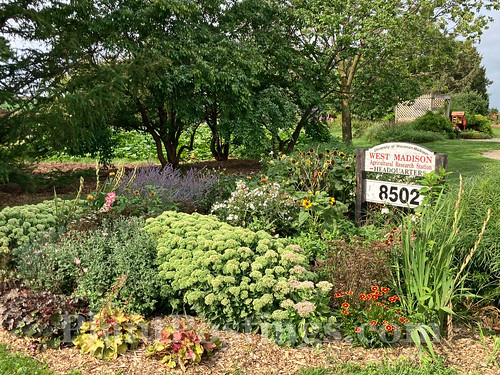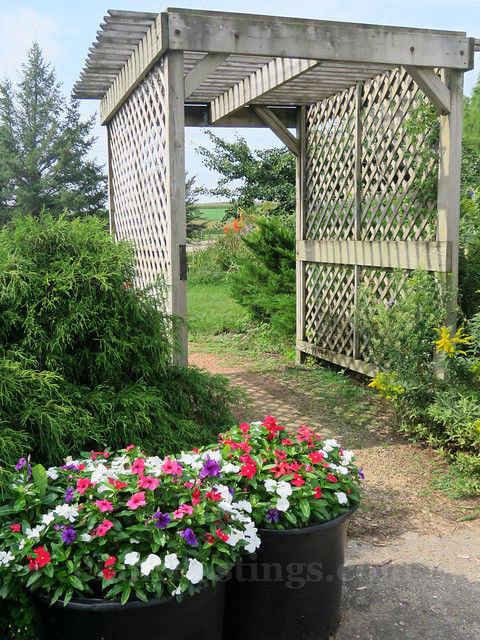
I've posted about the UW-Madison West Agricultural Research Station before, but I figured it would be a good time to head over there again to see what's growing. The display gardens and the research crops change from year to year.
Students and faculty at the university's College of Agricultural and Life Sciences have access to the gardens for research, agronomic and horticultural plant breeding and variety trials, community outreach, student training, and providing feed and manure management for the UW-Madison campus livestock.
Focus areas include field crops (corn, soybeans, small grains, alfalfa, and cover crops), plant breeding trials, vegetables, small fruit crops, composting, irrigation, and the horticultural display gardens (annuals and perennials). The latter include All-America Selections (AAS) winners.

I spent most of my time during this recent visit in the display gardens. There's a pretty little plant collection right out front, with annuals and perennials, welcoming people to the gardens.

Screen-protected areas display line-ups of various plant varieties; shown here, Coral Bells (Heuchera spp).

I spent most of my time during this recent visit in the display gardens. There's a pretty little plant collection right out front, with annuals and perennials, welcoming people to the gardens.

Screen-protected areas display line-ups of various plant varieties; shown here, Coral Bells (Heuchera spp).
The masses of open areas are fascinating, too, and beautiful!



One could spend hours viewing all these options!

One main reason I enjoy visiting these gardens is to see and track butterflies, like this silver-spotted skipper, for Wisconsinbutterflies.org. With all the flowering plants, the butterflies are plentiful, too.

On this particular day last week, I saw more than 20 monarchs, along with several other species.

Their favorite area seemed to be the Butterfly Bush (Buddleia davidii) display. And the favorite varieties on this particular day were 'Chrysalis Blue' and 'Chrysalis Cranberry.'

Some monarchs were still laying eggs on the plentiful native milkweeds in the gardens.

I was particularly tickled to see the popularity of the native Cup Plant (Silphium perfoliatum) blooms and other Silphium species, which were covered in various pollinators.

While I've seen Moneywort (Lysimachia alfredii) in gardens before, this variety, 'Night Light,' was quite attractive. Apparently, it prefers partial to full shade, the foliage turns burgundy in the shade, and it's rabbit-repellent (duly noted for my garden!).

The bumblebees were happy on Heliotrope 'Augusta Lavender' (Heliotropium hybrid). But who wouldn't be?

Now this plant had me curious, with its large fluffy, double blooms: 'Double Sunking' Sunflower (Helianthus annuus).

Its height, from various sources, is listed at six feet, but these plants were much taller!

I didn't make note of the species on this Canna Lily (Canna spp.), but I'm thinking it might be 'South Pacific Orange,' the 2018 AAS Flower Winner, and the one that I grew in 2019.




One could spend hours viewing all these options!

One main reason I enjoy visiting these gardens is to see and track butterflies, like this silver-spotted skipper, for Wisconsinbutterflies.org. With all the flowering plants, the butterflies are plentiful, too.

On this particular day last week, I saw more than 20 monarchs, along with several other species.

Their favorite area seemed to be the Butterfly Bush (Buddleia davidii) display. And the favorite varieties on this particular day were 'Chrysalis Blue' and 'Chrysalis Cranberry.'

Some monarchs were still laying eggs on the plentiful native milkweeds in the gardens.

I was particularly tickled to see the popularity of the native Cup Plant (Silphium perfoliatum) blooms and other Silphium species, which were covered in various pollinators.

While I've seen Moneywort (Lysimachia alfredii) in gardens before, this variety, 'Night Light,' was quite attractive. Apparently, it prefers partial to full shade, the foliage turns burgundy in the shade, and it's rabbit-repellent (duly noted for my garden!).

The bumblebees were happy on Heliotrope 'Augusta Lavender' (Heliotropium hybrid). But who wouldn't be?

Now this plant had me curious, with its large fluffy, double blooms: 'Double Sunking' Sunflower (Helianthus annuus).

Its height, from various sources, is listed at six feet, but these plants were much taller!

I didn't make note of the species on this Canna Lily (Canna spp.), but I'm thinking it might be 'South Pacific Orange,' the 2018 AAS Flower Winner, and the one that I grew in 2019.

I could have spent much more time in the display gardens--so much to see, and so many things to learn. I'm looking forward to a return during the next growing season!
Hi,
ReplyDeleteThis was fun. Thank you for sharing. I am in love with that Double Sunking Sunflower. I wonder how it holds up in a vase?
You are welcome. :) I wasn't familiar with the sunflower, so I'm not sure. It reminds me of a huge marigold. I can't decide whether I like it or not--from a distance it has some character, though.
DeleteYour comment about the Lysimachia deterring rabbits immediately had me looking it up but unfortunately it's ill-suited to my location. I rather like the bushy sunflower but I wonder if it has the same appeal to pollinators as the single-petaled varieties.
ReplyDeleteYes, I need to do more research about the Moneywort. I'm a little worried that it might take over, but I can see growing it in a pot. Good question about the Sunflower; I haven't decided whether I like it or not. It is interesting, though.
DeleteYou are lucky to have such a place close enough to visit.
ReplyDeleteThose big fluffy sunflowers were popular as 'Teddy Bear' sunflowers a few years ago. I haven't seen them so much lately tho.
Any plant that is rabbit resistant would be interesting to me but I need plants for shade or partial shade.
Yes, lucky indeed! I wasn't familiar with the puffy Sunflowers. Yes, I need shade-tolerant plants, too. I only have a small area that gets bright sun for a large portion of the day.
DeleteI grew South Pacific Orange cannas from seed this year, and while they are growing in pots, they have yet to bloom. They are still so tiny. I wonder what I'm doing wrong? Shrug. I love the AAS gardens in Stillwater at our botanic garden. Maybe I'll go visit. I like the Chysalis Cranberry. Have you heard that butterfly bushes aren't good for butterflies. One of my garden coaching clients said that. It's a new one on me. I know that some varieties are invasive in some part of the U.S., but not good for butterflies?
ReplyDeleteMine took forever to bloom, too; for me, I think it was the lack of sun. I have such a limited area for sun-loving plants...I have to experiment with partial sun, and sometimes it's just not enough. I guess I hadn't heard that butterfly bushes weren't good for butterflies, but like you, I was familiar with the invasiveness issues. I don't have any in my garden, but I've certainly considered them because the butterflies like them so much.
DeleteDelightful photographs; you're quite handy with the camera!
ReplyDeleteThank you. It's always fun to work with different angles and light settings. Still learning so much. :)
DeleteThis looks like such a wonderful place to visit. Brilliant photos and such a variety of colours.
ReplyDeleteYes, it's a fun and very colorful place. Thank you, Nikki.
DeleteHello there Beth ! This is a wonderful tour of a gorgeous place ;-)
ReplyDeleteThat Double Sunking sunflower makes me smile .. it is so darn cute!
I have been disappointed by the number of butterflies that have been visiting my garden .. I was so hoping for a year like we had when they almost massed on my hydrangea standard.
You got some great shots with them and the egg .. I could almost smell the that butterfly bush .. I miss not having that in the garden.
But ? I have had lots of beautiful bees and other pollinators so I am happy to see that. Joe Pye has made them happy too.
The moneywort ? .. it really deters rabbits ?! I bet a lot of gardeners are going to plant that now ! LOL
Stay safe and well .. very pretty and informative post !
Howdy! Thank you. :) Every year is different for me with butterflies. I feel like I had very few monarchs here in the beginning of the summer (it was a very dry June), but so many now. More tiger swallowtails than I usually do. Interesting. I don't know if Moneywort actually deters rabbits, but apparently they tend to avoid eating it...maybe that's how I should have phrased it? Still learning about it myself. Thanks. :)
DeleteA friend has been raving about the plants she is discovering out there, so it's fun to see some images. I rarely remember to stop by now that we don't have the plant sale there.
ReplyDeleteYes, it's definitely worth a trip every year. I hadn't been out there for a while, so it was a fun visit.
DeleteThanks for this visit, Beth. Whenever I travel (not that it's happened recently...:), I thoroughly enjoy going to research and experimental gardens, mostly (like this one) connected to colleges and universities. Nice set of shots!
ReplyDeleteYou are welcome! Thanks for stopping by. I agree: I also enjoy visiting research gardens...well, just about any type of garden. ;-)
DeleteBeautiful blog
ReplyDeleteThank you, and thanks for stopping by!
DeleteFantastic photos and beautiful flowers! I love to visit gardens. Thanks for letting me visit this one with you! I just finished a quirky, sometimes funny book written about Wisconsin. Chasing Turkeys by Kenton Whitman. I of course thought of you!
ReplyDeleteThanks, Becky. I'll have to look into that book. Thanks for the tip!
DeleteThat looks like a wonderful place. Lovely to see happy bees and butterflies--more benefit from this place than just farmers and gardeners!
ReplyDeleteWe have a UC Agricultural research station nearby--mostly for dragon fruit, citrus, and avocados, plus some low-water demonstration gardens for local homeowners.
Research gardens are fascinating, aren't they? And, yes, the side benefits to pollinators is fabulous. Heck, any garden is wonderful. LOL.
DeleteDouble sunking is eye candy, but no pollen or seeds?
ReplyDeleteTrue. I imagine seeds, but the pollen would be hard to access!
Delete